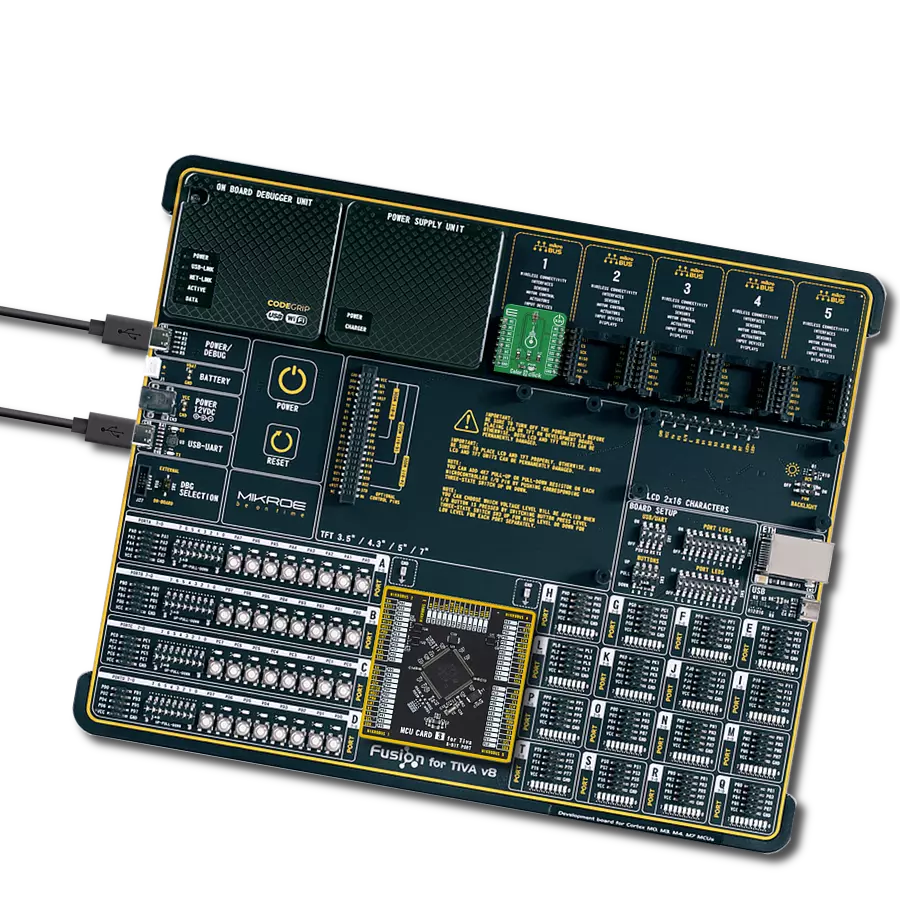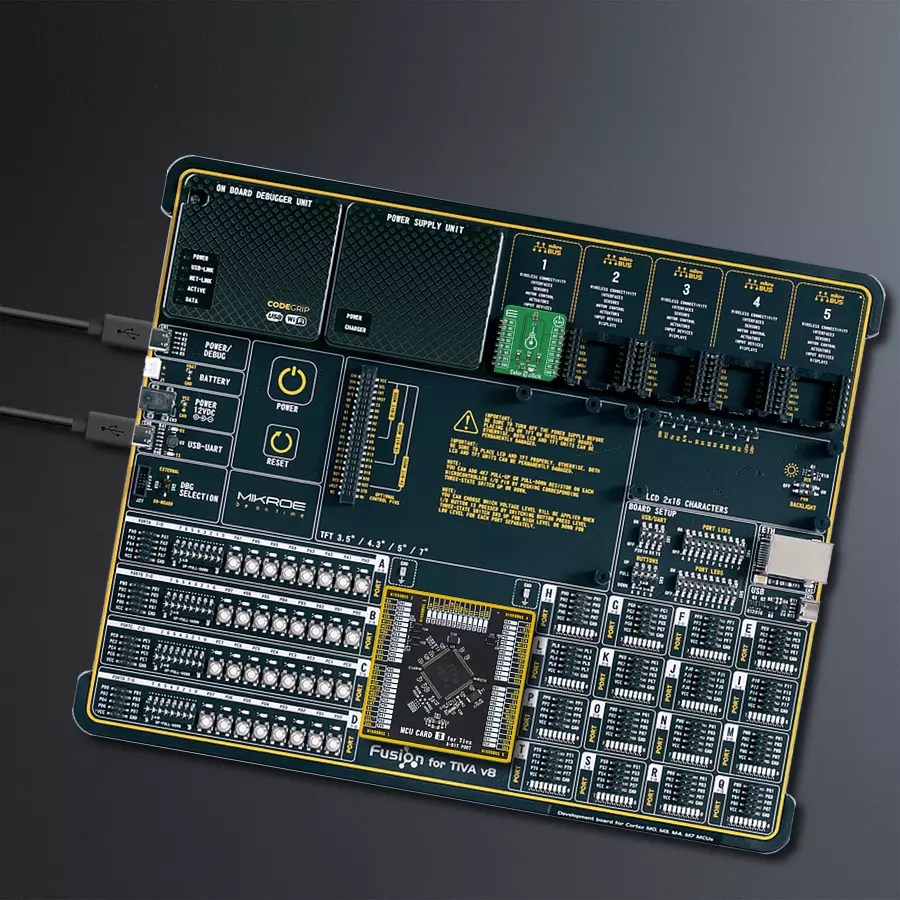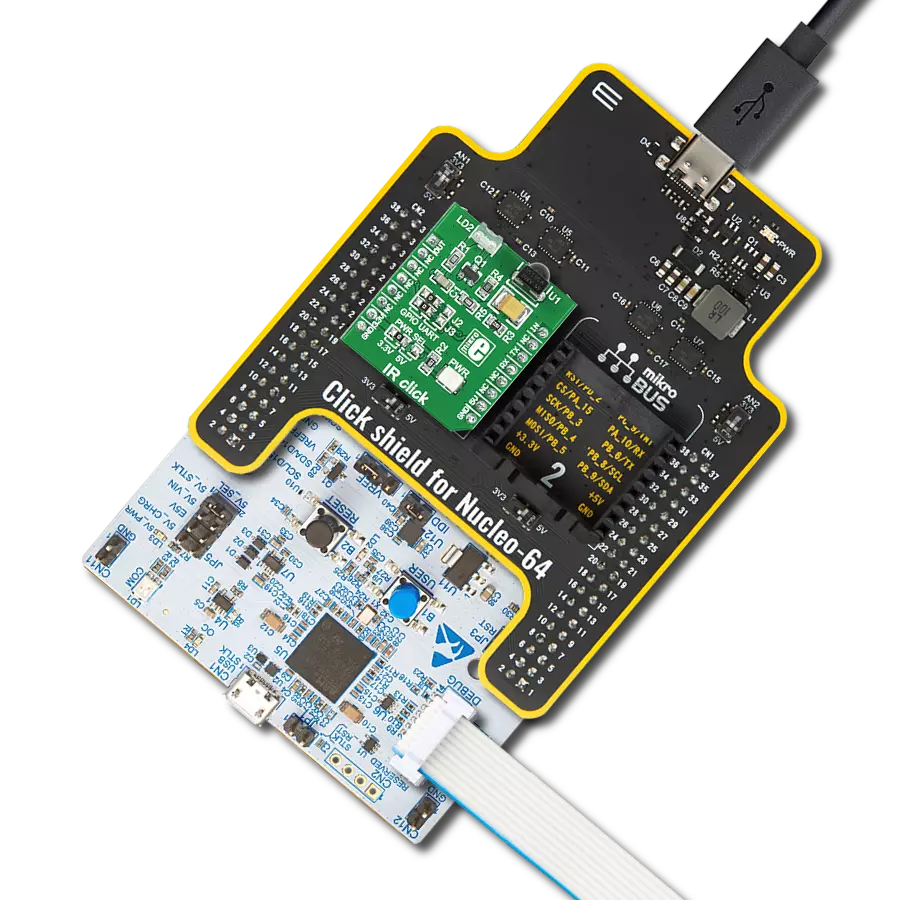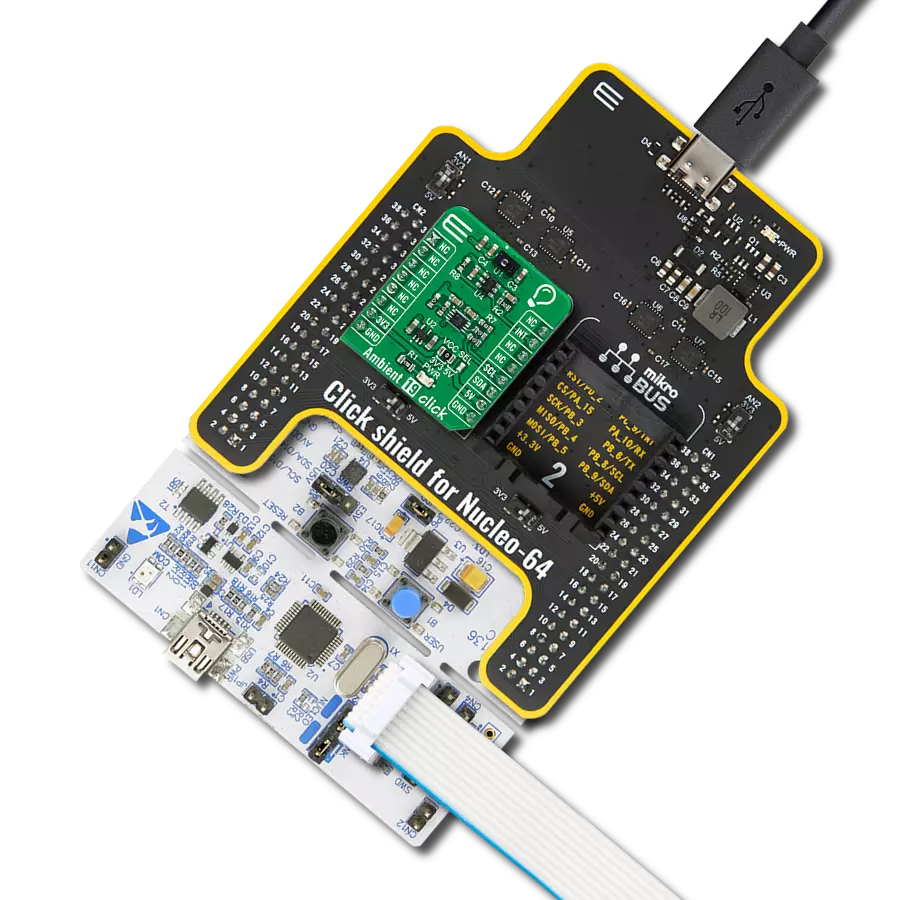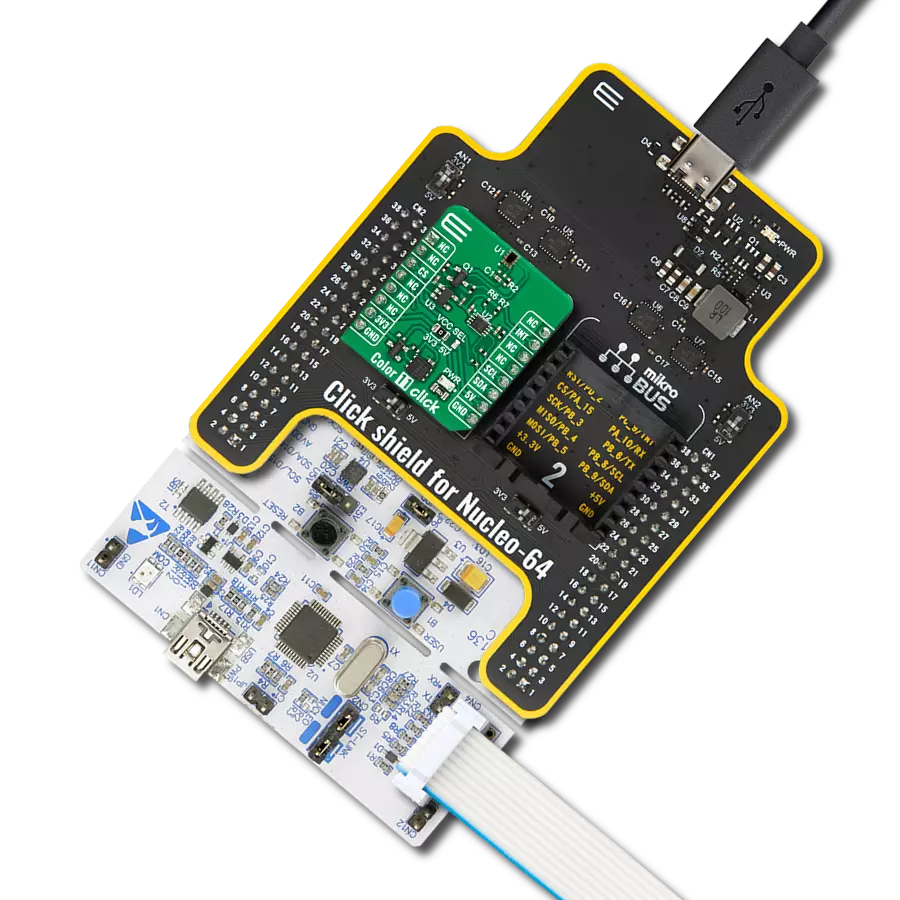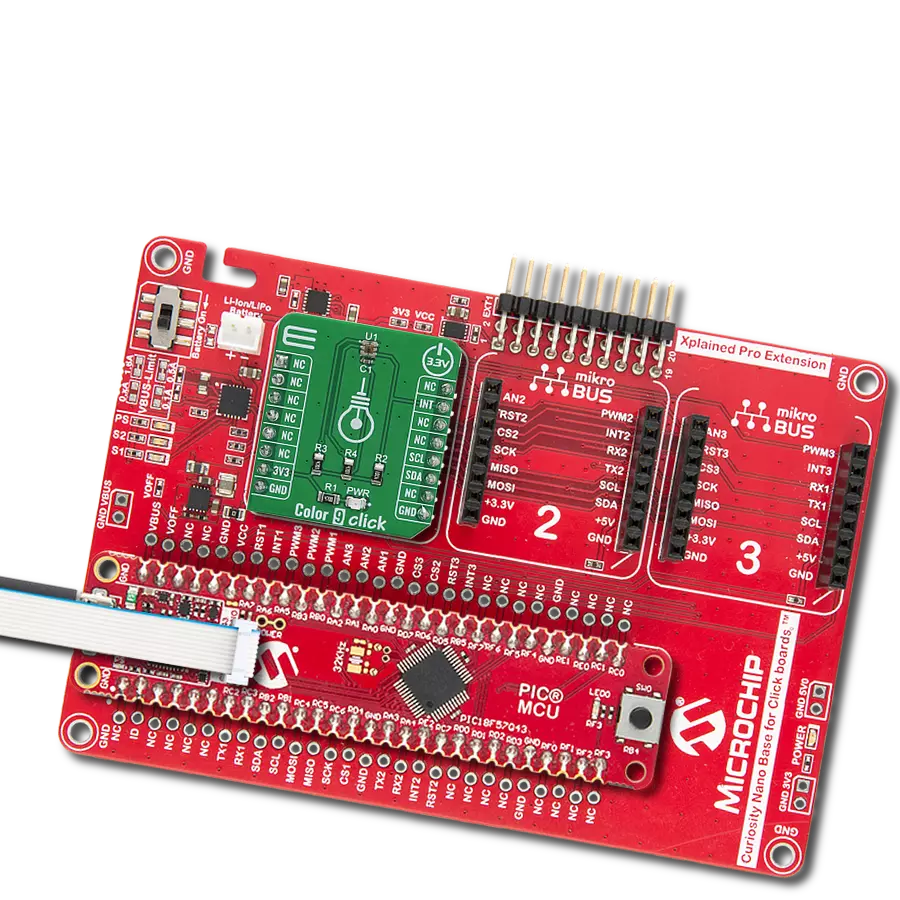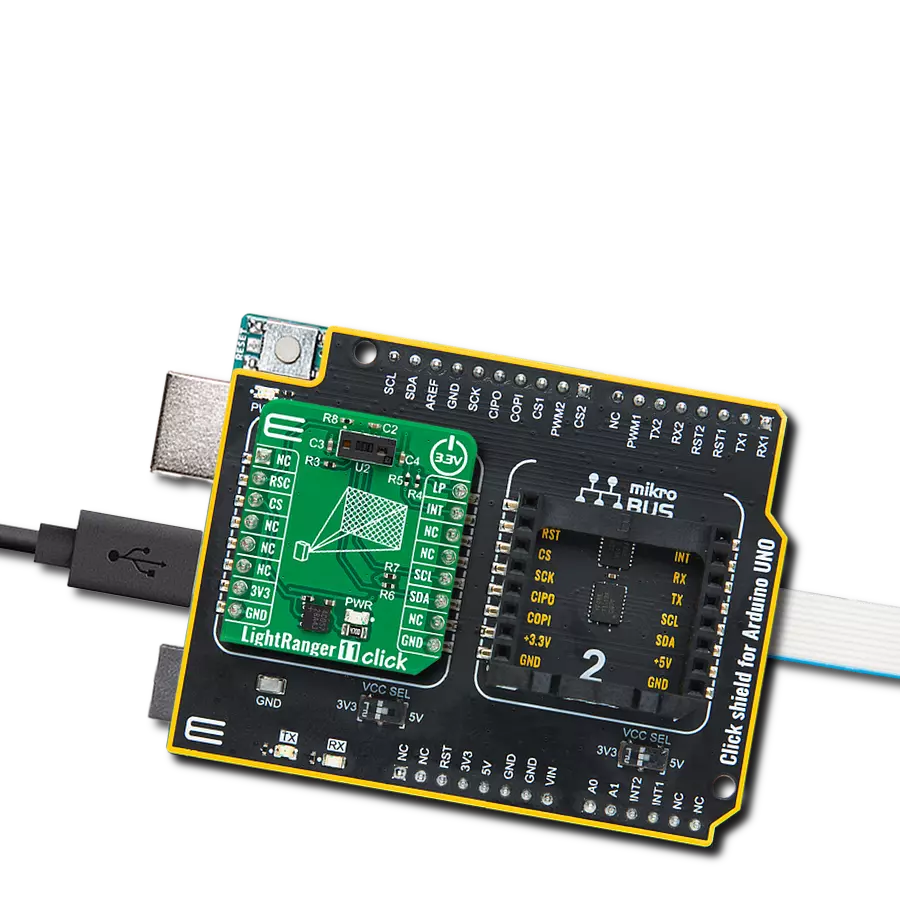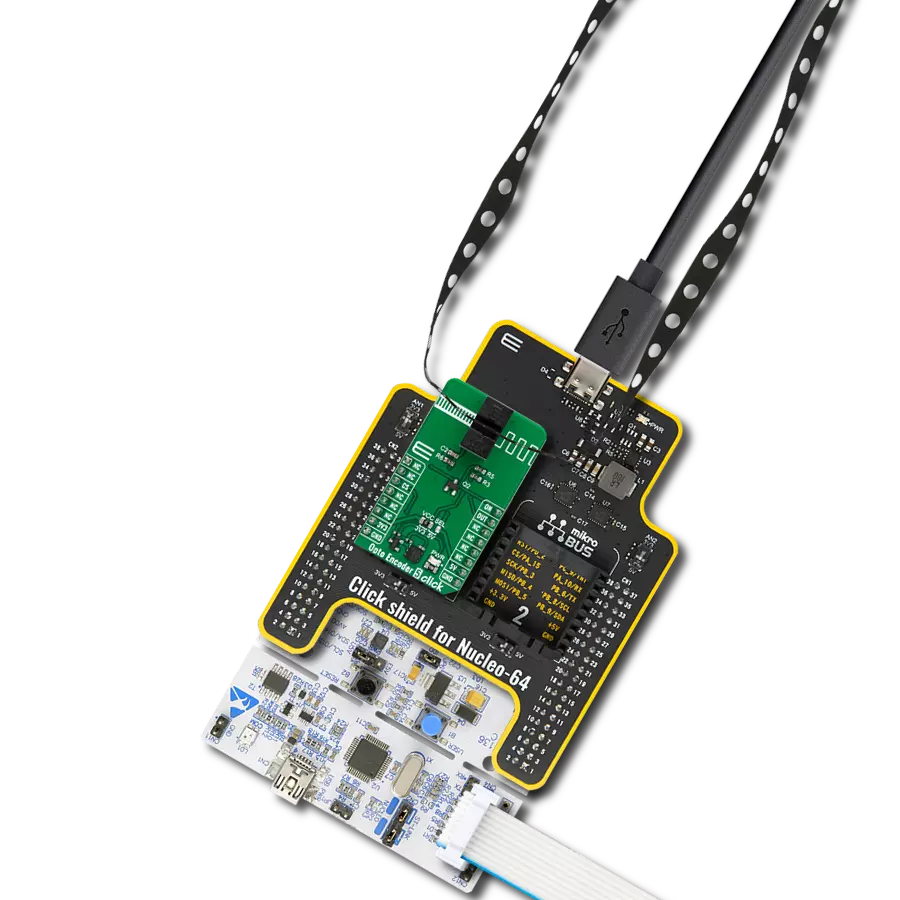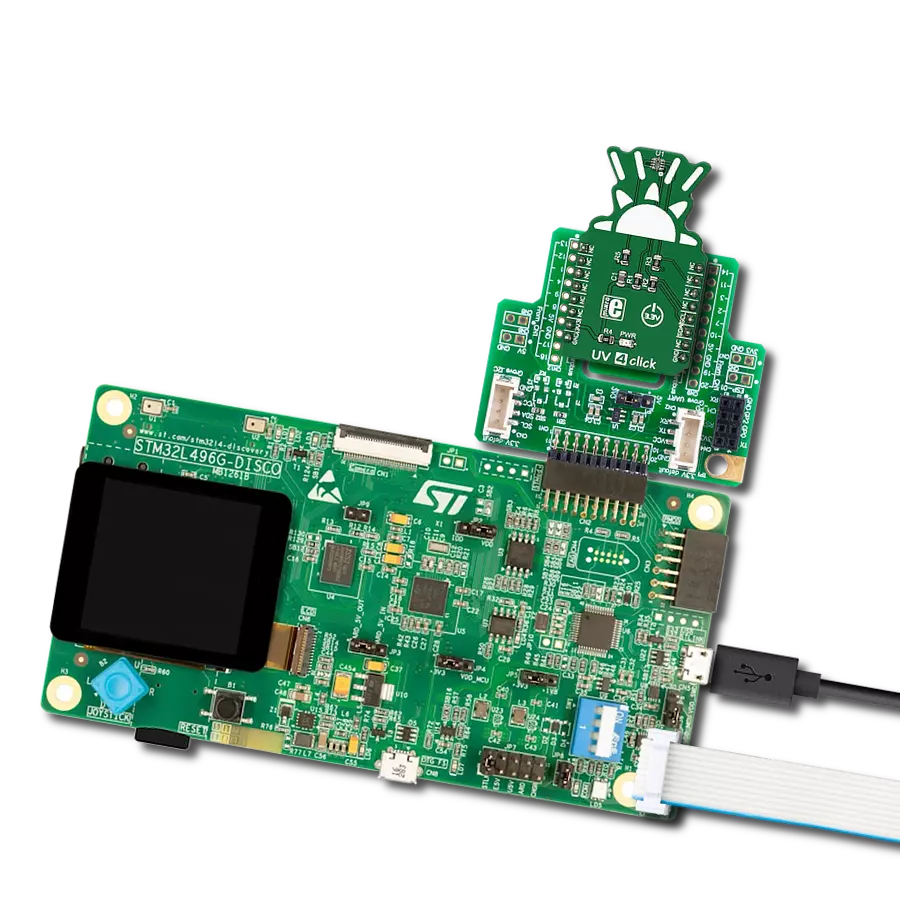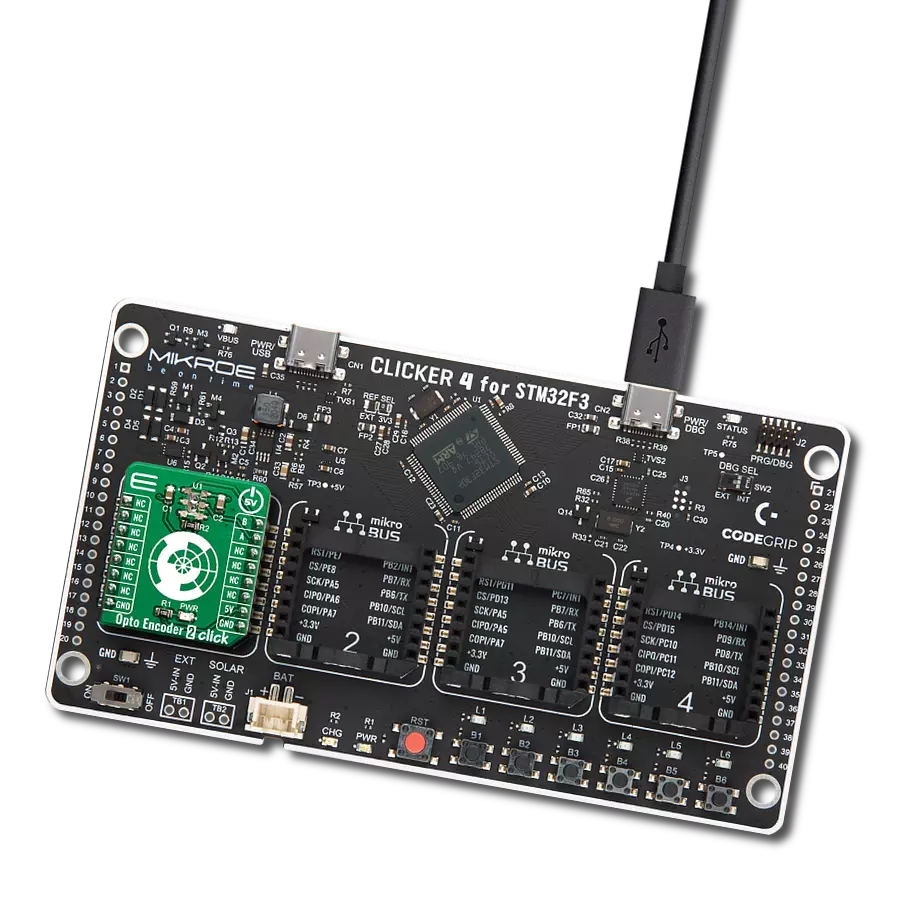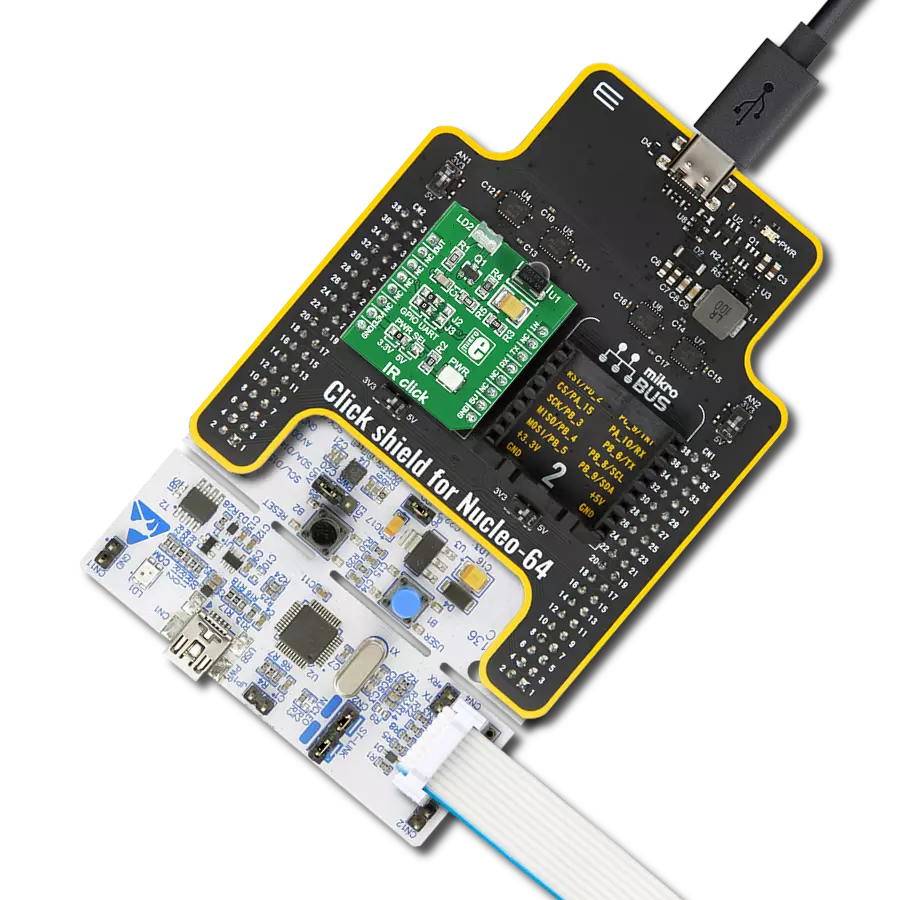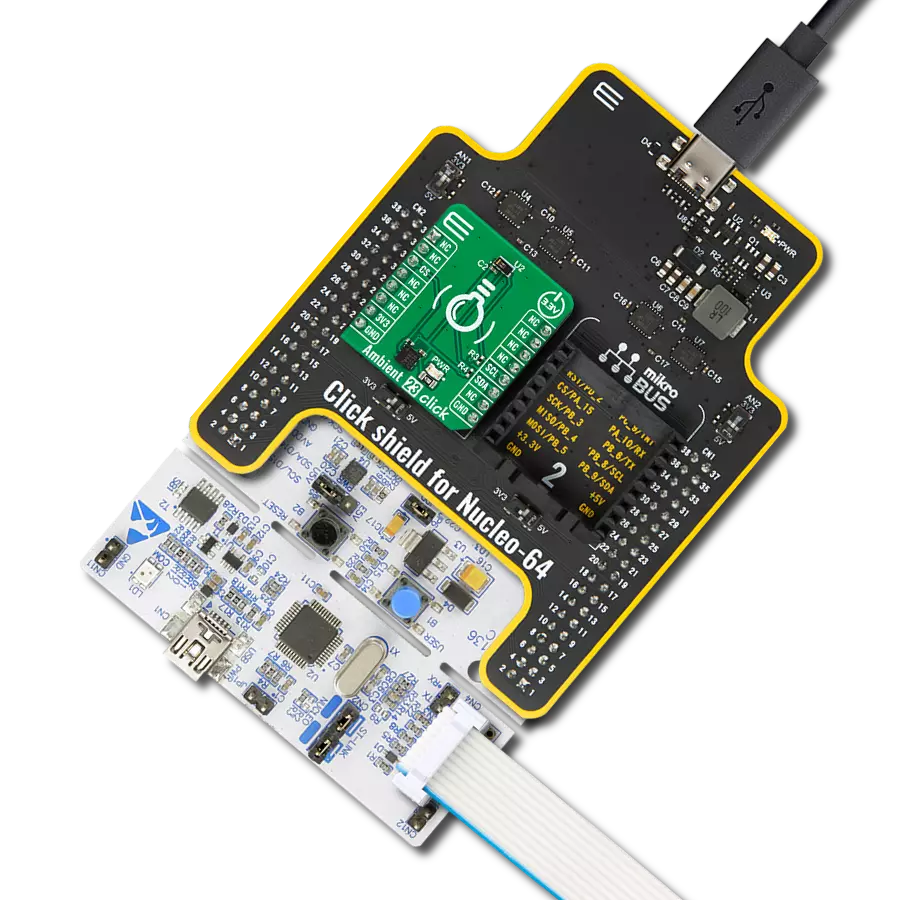With our color sensing solution, you can confidently address applications such as color matching, printing, and textile production, where precise color detection is paramount to success
A
A
Hardware Overview
How does it work?
Color 9 Click is based on the APDS-9250, an integrated color sensor IC from Broadcom. This highly advanced four-channel color sensing device incorporates an IR blocking filter, that is used to block a portion of light in the IR spectrum, which can interfere with the readings of three independent photo-diodes, used to sense red, green and blue components of the light. However, it features an additional IR photo-sensing element, which is used to detect the intensity in the IR range. The IR measurement value can be used as a compensation parameter for the accurate color calculation. The color intensity sensing is roughly matched to the sensitivity of the human eye, so the sensor is the most sensitive in the range between 500nm and 600nm. The datasheet of the APDS-9250 offers an intensity over the wavelength diagram, so an accurate color calculation can be made in respect to the variable sensitivity of the sensor over the light wavelength. There are four independent A/D converters which are used to
digitize the color intensity in 18-bit resolution. The color and IR conversion results are available at the output registers in MSB/LSB format. Color 9 click communicates with the host MCU over the I2C interface, with its pin routed to the appropriate SCL and SDA pins of the mikroBUS™. The powerful interrupt engine allows more optimized firmware for the controller (MCU) to be written. The interrupt engine allows 16-bit values for the upper and lower threshold levels to be defined, as well as the persistence interval during which the event has occurred, before the interrupt is triggered, and more. Also, the user has the possibility to select which channel is included in the interrupt event detection.The APDS-9250 requires a very low number of external components. It requires only pull-up resistors for the I2C bus lines and the INT pin, which is an open-drain interrupt line. To allow for the best performance and most accurate measurements, the surface of the board and especially the
sensor IC itself, should always stay clean and without scratches, as dirt and moisture can after the light penetration through the filters. In addition, the manufacturer recommends that the angle of incidence stays less than 10° since the sensor IC has an aperture angle (beam width) of nearly 90°. If the angle of incidence is greater than advised, the filter shifting might occur, introducing distortion and affecting the measurement results. The spectral filters of this sensor are specialized for working with the broadband source of light, and measurement of the narrowband light sources should not be performed by this sensor. This Click board™ can be operated only with a 3.3V logic voltage level. The board must perform appropriate logic voltage level conversion before using MCUs with different logic levels. Also, it comes equipped with a library containing functions and an example code that can be used as a reference for further development.
Features overview
Development board
Fusion for TIVA v8 is a development board specially designed for the needs of rapid development of embedded applications. It supports a wide range of microcontrollers, such as different 32-bit ARM® Cortex®-M based MCUs from Texas Instruments, regardless of their number of pins, and a broad set of unique functions, such as the first-ever embedded debugger/programmer over a WiFi network. The development board is well organized and designed so that the end-user has all the necessary elements, such as switches, buttons, indicators, connectors, and others, in one place. Thanks to innovative manufacturing technology, Fusion for TIVA v8 provides a fluid and immersive working experience, allowing access
anywhere and under any circumstances at any time. Each part of the Fusion for TIVA v8 development board contains the components necessary for the most efficient operation of the same board. An advanced integrated CODEGRIP programmer/debugger module offers many valuable programming/debugging options, including support for JTAG, SWD, and SWO Trace (Single Wire Output)), and seamless integration with the Mikroe software environment. Besides, it also includes a clean and regulated power supply module for the development board. It can use a wide range of external power sources, including a battery, an external 12V power supply, and a power source via the USB Type-C (USB-C) connector.
Communication options such as USB-UART, USB HOST/DEVICE, CAN (on the MCU card, if supported), and Ethernet is also included. In addition, it also has the well-established mikroBUS™ standard, a standardized socket for the MCU card (SiBRAIN standard), and two display options for the TFT board line of products and character-based LCD. Fusion for TIVA v8 is an integral part of the Mikroe ecosystem for rapid development. Natively supported by Mikroe software tools, it covers many aspects of prototyping and development thanks to a considerable number of different Click boards™ (over a thousand boards), the number of which is growing every day.
Microcontroller Overview
MCU Card / MCU
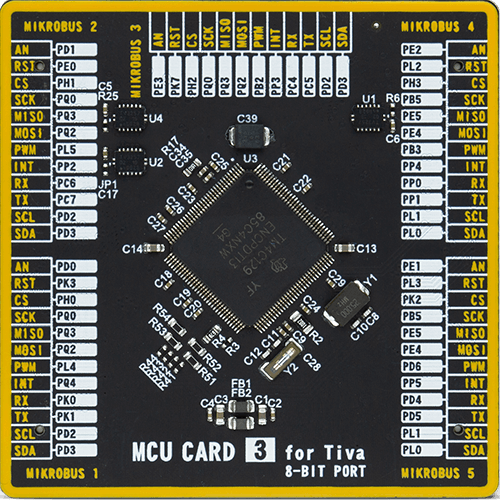
Type
8th Generation
Architecture
ARM Cortex-M4
MCU Memory (KB)
1024
Silicon Vendor
Texas Instruments
Pin count
128
RAM (Bytes)
262144
Used MCU Pins
mikroBUS™ mapper
Take a closer look
Click board™ Schematic

Step by step
Project assembly
Track your results in real time
Application Output
1. Application Output - In Debug mode, the 'Application Output' window enables real-time data monitoring, offering direct insight into execution results. Ensure proper data display by configuring the environment correctly using the provided tutorial.

2. UART Terminal - Use the UART Terminal to monitor data transmission via a USB to UART converter, allowing direct communication between the Click board™ and your development system. Configure the baud rate and other serial settings according to your project's requirements to ensure proper functionality. For step-by-step setup instructions, refer to the provided tutorial.

3. Plot Output - The Plot feature offers a powerful way to visualize real-time sensor data, enabling trend analysis, debugging, and comparison of multiple data points. To set it up correctly, follow the provided tutorial, which includes a step-by-step example of using the Plot feature to display Click board™ readings. To use the Plot feature in your code, use the function: plot(*insert_graph_name*, variable_name);. This is a general format, and it is up to the user to replace 'insert_graph_name' with the actual graph name and 'variable_name' with the parameter to be displayed.

Software Support
Library Description
This library contains API for Color 9 Click driver.
Key functions:
color9_get_green- This function gets Green measurement readingcolor9_get_blue- This function gets Blue measurement readingcolor9_get_red- This function gets Red measurement reading.
Open Source
Code example
The complete application code and a ready-to-use project are available through the NECTO Studio Package Manager for direct installation in the NECTO Studio. The application code can also be found on the MIKROE GitHub account.
/*!
* \file
* \brief Color9 Click example
*
* # Description
* This application collects data from the sensor and logs green, blue and red
* measurement readings.
*
* The demo application is composed of two sections :
*
* ## Application Init
* Initialize the driver and test if the sensor is
* present. If the ID read from the sensor is correct
* execute the initialization procedure.
*
* ## Application Task
* Wait for the color data to be available then read the data
* and send it to the serial port.
*
*
* \author MikroE Team
*
*/
// ------------------------------------------------------------------- INCLUDES
#include "board.h"
#include "log.h"
#include "color9.h"
// ------------------------------------------------------------------ VARIABLES
static color9_t color9;
static log_t logger;
// ------------------------------------------------------ APPLICATION FUNCTIONS
void application_init ( void )
{
log_cfg_t log_cfg;
color9_cfg_t cfg;
uint8_t id;
/**
* Logger initialization.
* Default baud rate: 115200
* Default log level: LOG_LEVEL_DEBUG
* @note If USB_UART_RX and USB_UART_TX
* are defined as HAL_PIN_NC, you will
* need to define them manually for log to work.
* See @b LOG_MAP_USB_UART macro definition for detailed explanation.
*/
LOG_MAP_USB_UART( log_cfg );
log_init( &logger, &log_cfg );
log_info( &logger, "---- Application Init ----" );
// Click initialization.
color9_cfg_setup( &cfg );
COLOR9_MAP_MIKROBUS( cfg, MIKROBUS_1 );
color9_init( &color9, &cfg );
id = color9_read( &color9, COLOR9_PART_ID );
if ( id == 0xB2 )
{
log_printf( &logger, "Register id 0x%x\r\n", id );
color9_meas_rate( &color9, COLOR9_LS_MEAS_BITWIDTH_13, COLOR9_LS_MEAS_RATE_1000ms );
color9_reg_ctrl( &color9, COLOR9_MAIN_CTRL_CS_MODE | COLOR9_MAIN_CTRL_LS_EN );
}
else
{
log_printf( &logger, "Error\r\n" );
while ( 1 );
}
}
void application_task ( void )
{
uint8_t conv_complete;
uint32_t measurement_data;
conv_complete = color9_get_status_reg( &color9 );
if ( conv_complete & 0x08 )
{
conv_complete = 0;
measurement_data = color9_get_Ir( &color9 );
log_printf( &logger, "Ir: %d\r\n", measurement_data );
measurement_data = color9_get_green( &color9 );
log_printf(&logger, "Green: %d\r\n", measurement_data);
measurement_data = color9_get_blue( &color9 );
log_printf(&logger, "Blue: %d\r\n", measurement_data);
measurement_data = color9_get_red( &color9 );
log_printf(&logger, "Red: %d\r\n", measurement_data);
}
}
int main ( void )
{
/* Do not remove this line or clock might not be set correctly. */
#ifdef PREINIT_SUPPORTED
preinit();
#endif
application_init( );
for ( ; ; )
{
application_task( );
}
return 0;
}
// ------------------------------------------------------------------------ END
